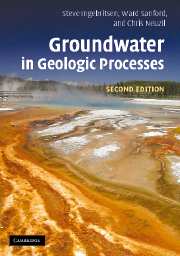Book contents
- Frontmatter
- Contents
- Preface
- Acknowledgements
- List of symbols
- 1 Groundwater flow
- 2 Hydromechanical coupling
- 3 Solute transport
- 4 Heat transport
- 5 Regional-scale flow and transport
- 6 Ore deposits
- 7 Hydrocarbons
- 8 Geothermal processes
- 9 Earthquakes
- 10 Evaporites
- 11 Compaction and diagenesis
- 12 Metamorphism
- 13 Subsea hydrogeology
- References
- Index
7 - Hydrocarbons
Published online by Cambridge University Press: 12 January 2023
- Frontmatter
- Contents
- Preface
- Acknowledgements
- List of symbols
- 1 Groundwater flow
- 2 Hydromechanical coupling
- 3 Solute transport
- 4 Heat transport
- 5 Regional-scale flow and transport
- 6 Ore deposits
- 7 Hydrocarbons
- 8 Geothermal processes
- 9 Earthquakes
- 10 Evaporites
- 11 Compaction and diagenesis
- 12 Metamorphism
- 13 Subsea hydrogeology
- References
- Index
Summary
A hydrocarbon is any organic compound – gaseous, liquid, or solid – consisting solely of carbon and hydrogen. Petroleum or crude oil is essentially a complex mixture of liquid hydrocarbons. Natural gas refers to hydrocarbons that exist as a gas or vapor, with methane (CH4) usually the main component. The origin, migration, and entrapment of these soughtafter fluid hydrocarbons are intimately linked to groundwater flow. The thermal effects of groundwater movement may influence the position of the temperature “window” that favors the initial maturation of organic matter into hydrocarbons. The poorly understood process of expulsion or primary migration of hydrocarbons from shaley source rocks into more permeable rocks is influenced by the capillary and relative-permeability relations between aqueous fluids and hydrocarbons. The required expulsive force may be provided by elevated fluid pressures (Section 5.2) related to hydrocarbon maturation. Hydrodynamic forces influence patterns of secondary migration through more permeable rocks toward reservoirs where “traps” concentrate hydrocarbons in economically significant quantities. The actual location and configuration of hydrocarbon traps are influenced both by regional-scale hydrodynamic forces and by more local capillary effects. Finally, groundwater flow with bacterial action can act to biodegrade a mobile oil to a viscous, immobile, asphaltine substance. The movement of hydrocarbons can be described by a set of three coupled governing equations for groundwater, oil, and gas. Each of these expressions is analogous in most respects to the equation for variable-density groundwater flow that was derived in Section 1.5 and invoked in Chapters 3 and 4. Some quantitative analyses of petroleum systems (e.g., the Uinta basin case study described here) solve a complete system of governing equations; others (e.g., the Los Angeles basin case) solve only for groundwater flow, and then use the groundwater flow field as a basis for inferring hydrocarbon movement.
Thermal maturation
Economically significant quantities of hydrocarbons are generated from lacustrine, terrigenous, or marine organic matter deposited and preserved in low-energy lacustrine or marine sedimentary environments. In higherenergy sedimentary environments, organic matter is winnowed out or oxidized so that it is unable to accumulate in significant quantities. Thus most hydrocarbon source rocks are shales, rather than sandstones or carbonates, though there are some carbonate and biosiliceous source rocks.
- Type
- Chapter
- Information
- Groundwater in Geologic Processes , pp. 220 - 246Publisher: Cambridge University PressPrint publication year: 2006



